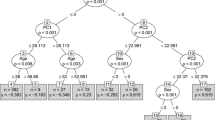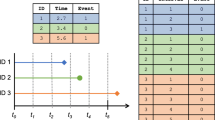Abstract
Diverse measures for predictive accuracy have been developed for survival data which require additional investigation to reflect the time dependent outcomes. In this chapter, our purpose is to review several methods to evaluate prediction models and to compare their performance in a context of interval censored data. This chapter provides conceptual and practical explanation of statistical methods for the time-dependent ROC and C-index as the discrimination measure. Also, Brier score is dealt to evaluate overall performance for the prediction model. We aim to provide clarity of each method and identify software tools to carry out analysis in practice. We illustrate the methods using a dementia dataset.
Access this chapter
Tax calculation will be finalised at checkout
Purchases are for personal use only
Similar content being viewed by others
References
Akritas, M. G. (1994), Nearest neighbor estimation of a bivariate distribution under random censoring. Annals of Statistics, 22, 1299–1327.
Anderson-Bergman, C. (2017). icenReg: Regression models for interval censored data in R. Journal of Statistical Software, 81(12), 1–23.
Asano, J., & Hirakawa, A. (2017). Assessing the prediction accuracy of a cure model for censored survival data with long-term survivors: Application to breast cancer data. Journal of Biopharmaceutical statistics, 27, 918–932.
Beyene, K. M., Ghouch, A. E., & Oulhaj, A. (2019). On the validity of time-dependent AUC estimation in the presence of cure fraction. Biometrical Journal, 61, 1430–1447.
Blanche, P., Dartigues, J. F., & Jacqmin-Gadda, H. (2013a). Review and comparison of ROC curve estimators for a time-dependent outcome with marker-dependent censoring. Biometrical Journal, 55, 687–704.
Blanche, P., Dartigues J. F, & Jacqmin-Gadda, H. (2013b). Estimating and comparing time-dependent areas under receiver operating characteristic curves for censored event times with competing risks. Statistics in Medicine, 32, 5381–5397.
Brown, B. W., Hollander, M., & Korwar, R. M. (1974). Nonparametric tests of independence for censored data, with applications to heart transplant studies. Reliability and Biometry, 34, 327–354.
Chambless, L. E., & Diao, G. (2006). Estimation of time-dependent area under the ROC curve for long-term risk prediction. Statistics in Medicine, 25, 3474–3486.
Díaz-Coto, S., Martínez-Camblor, S., & Corral-Blanco, N. O. (2020), Cumulative/dynamic ROC curve estimation under interval censorship. Journal of Statistical Computation and Simulation, 90, 1570–1590.
Foucher, Y., Giral, M., Soulillou, J. P., & Daures, J. P. (2010). Time-dependent ROC analysis for a three-class prognostic with application to kidney transplantation. Statistics in Medicine, 29, 3079–3087.
Fu, W., & Simonoff, J. S. (2017). Survival trees for interval censored survival data. Statistics in Medicine, 36(30), 4831–4842.
Gerds, T. A., Kattan, M. W., Schumacher, M., & Yu, C. (2013). Estimating a time-dependent concordance index for survival prediction models with covariate dependent censoring. Statistics in Medicine, 32, 2173–2184.
Gerds, T. A., & Schumacher, M. (2006). Consistent estimation of the expected Brier score in general survival models with right-censored event times. Biometrical Journal, 48, 1029–1040.
Graf, E., Schmoor, C., Sauerbrei, W., & Schumacher, M. (1999). Assessment and comparison of prognostic classification schemes for survival data. Statistics in Medicine , 18, 2529–2545.
Harrell, F. E., Califf, R. M., Pryor, D. B., Lee, K. L., & Rosati, R. A. (1982). Evaluating the yield of medical tests. Journal of the American Medical Association, 247, 2543–2546.
Harrell, F. E., Lee, K. L., & Mark, D. B. (1996). Multivariable prognostic models: Issues in developing models, evaluating assumptions and adequacy, and measuring and reducing errors. Statistics in Medicine, 15, 361–387.
Heagerty, P. J., Lumley, T., & Pepe, M. S. (2000). Time-dependent ROC curves for censored survival data and a diagnostic marker. Biometrics, 56, 337–344.
Heagerty, P. J., Saha-Chaudhuri, P., & Saha-Chaudhuri, M. P.(2013). survivalROC:. R package version1.0.5. https://cran.r-project.org/web/packages/survivalROC/survivalROC.pdf
Heagerty, P. J., Saha-Chaudhuri, P., & Saha-Chaudhuri, M. P. (2012). risksetROC:. R package version1.0.5. https://cran.r-project.org/web/packages/risksetROC/risksetROC.pdf
Heagerty, P. J., & Zheng, Y. (2005). Survival model predictive accuracy and ROC curves. Biometrics, 61, 92–105.
Hung, H., & Chiang, C. T. (2010). Optimal composite markers for time-dependent receiver operating characteristic curves with censored survival data. Scandinavian Journal of Statistics, 37(4), 664–679.
Jacqmin-Gadda, H., Blanche, P., Chary, E., Touraine, C., & Dartigues, F. G. (2016). Receiver operating characteristic curve estimation for time-to-event with semicompeting risks and interval censoring. Staticcal Methods in Medical Research, 25(6), 2750–2766.
Kamarudin, A. N., Cox, T., & Kolamunnage-Dona, R. (2017). Time-dependent ROC curve analysis in medical research: Current methods and applications. BMC Medical Research Methodology, 17, 53.
Korn, E. L., & Simon, R. (1990). Measures of explained variation for survival data. Statistics in Medicine, 9, 487–503.
Letenneur, L., Commenges, D., Dartigues, J. F., & arberger-Gateau, P. (1994). Incidence of dementia and Alzheimer’s disease in elderly community residents of south-western France. International Journal of Epidemiology, 23(6), 1256–1261.
Li, J., & Ma, S. (2011). Time-dependent ROC analysis under diverse censoring patterns. Statistics in Medicine, 30, 1266–1277.
Lindsey, J. C., & Ryan, L. M. (1998). Tutorial in Biostatistics methods for interval-censored data. Statistics in Medicine, 17, 219–238.
Mogensen, U. B., Ishwaran, H., & Gerds T. A. (2012). Evaluating random forests for survival analysis using prediction error curves. Journal of Statistical Software, 50(11), 1–23.
Pepe, M. S. (2003). The statistical evaluation of medical tests for classification and prediction. Oxford: Oxford University Press.
Potapov, S., Adler, W., & Schmid, M. (2012). survAUC: Estimators of prediction accuracy for time-to-event data. R package version 1.0-5.
Proust-Lima, C., Philipps, V., & Liquet, B. (2017). Estimation of extended mixed models using latent classes and latent processes: The R package. lcmm.
Rizopoulos, D. (2011). Dynamic predictions and prospective accuracy in joint models for longitudinal and time-to-event data. Biometrics, 67, 819–829.
Tsouprou, S. (2015). Measures of Discrimination and Predictive Accuracy for Interval-Censored Data. Master Thesis, Leiden University.
Turnbull, B. (1976). The empirical distribution with arbitrarily grouped and censored data. Journal of the Royal Statistical Society, B, 38(3), 290–295.
Uno, H., Cai, T. X., Tian, L., & Wei, L. J. (2007). Evaluating prediction rules for t-year survivors with censored regression models. Journal of the American Medical Association, 102, 527–537.
Uno. H., Cai, T., Pencina, M. J., D’Agostino, R. B., & Wei, L. J. (2011). On the C-statistics for evaluating overall adequacy of risk prediction procedures with censored survival data. Statistics in Medicine, 30, 1105–1117.
Wang, Z., & Wang, X. (2020). Evaluating the time-dependent predictive accuracy for event-to-time outcome with a cure fraction. Pharmaceutical Statistics, 19, 955–974.
Wolbers, M., Blanche, P., Koller, M. T., Witteman, J. M., & Gerds, T. A. (2014). Concordance for prognostic models with competing risks. Biostatistics, 15, 526–539.
Wu, Y., & Cook, R. J. (2022). Assessing the accuracy of predictive models with interval-censored data. Biostatistics, 23, 18–33.
Wu, Y., & Zhang, Y. (2012). Partially monotone tensor spline estimation of the joint distribution function with bivariate current status data. Annals of Statistics, 40, 1609–1636.
Yao, W., Frydman, H., & Simonoff, J. (2021). An ensemble method for interval-censored time-to-event data. Biostatistics, 22, 198–213.
Wu, Y., Wang, X., Li, J., Jia, B., & Owzar, K. (2020). Predictive accuracy of markers or risk scores for interval censored survival data. Statistics in Medicine, 39, 2437–2446.
Zheng, Y., & Heagerty, P. J. (2007). Prospective accuracy for longitudinal markers. Biometrics, 63(2), 332–341.
Acknowledgements
This research was supported by Korea National research foundation (NRF-2020R1A2C1A01100755).
Appendix: R code
a. Calculation of AUC
We modified the intDCroc function Díaz-Coto et al. (2020) provided by implementing nonparametric approach and Li and Ma’s approach. A function intCD2roc has four components, (TL, TR, M, k), where k indicates which method is applied. In detail, k = 1 :Li and Ma approach; k = 2: weights based on nonparametric estimator and k = 3 weights based on semiparametric estimator. Function intDC2roc can be downloaded from Springer weblink.
TL left interval time
TR right interval time (TR = TL at packages intcensROC)
M marker value (ex:\(M=X{'}\hat {\beta }\) )
time a time point to obtain the AUC
delta censoring indicator (1:left, 2:interval, 3:right censoring)
LM=intCD2roc(cbind(TL,TR,M),time,1)
IM=intCD2roc(cbind(TL,TR,M),time,2)
DC=intCD2roc(cbind(TL,TR,M),time,3)
res=intcensROC(TL, TR1,M, delta,time,gridNumber = 100)
auc_LM=LM[["auc"]]
auc_IM=IM[["auc"]]
auc_DC=DC[["auc"]]
auc_SM<-intcensAUC(res)
plot(c(0,1),c(0,1), xlab="1-spec", ylab="sens", main="time")
lines(FP_IM[order(TP_IM)],sort(TP_IM), type="l", lty=1)
lines(FP_LM[order(TP_LM)],sort(TP_LM), type="l", lty=3)
lines(FP_SM[order(TP_SM)],sort(TP_SM), type="l", lty=2)
lines(FP_DC[order(TP_DC)],sort(TP_DC), type="l", lty=4)
legend("bottomright", legend=c("IM","SM","LM","CD"), lty=c(1:4)) print(c(auc_IM,auc_SM,auc_LM,auc_DC))
b. Calculation of C-index
A marker is defined as a linear predictor given a model. Function intCindex can be downloaded from Springer weblink. A function intCindex(d, k) requires the following data:
d: dataset including (TL, TR, X)
k: (=1: ph model; 2: po model)
intCindex(d,1)
intCindex(d,2)
c. Calculation of IBS
For calculation of IBS of a imputation point, the packages ipred and pec are implemented. For interval censored data, the function sbrier_IC in a package ICcforest is used. The following variables are defined
obj <- Surv(TL, TR2,type = "interval2")
pred <-icenReg::ic_sp(formula = Surv(TL,TR, type = "interval2") 1,data=d)
pred2<-icenReg::ic_sp(formula = Surv(TL,TR, type = "interval2") X1+X2+X3+X4+X5,data=d)
sbrier_IC(obj, pred, type="IBS")[1]
sbrier_IC(obj, pred2, type="IBS")[1]
TR1<-ifelse(censor==0,99999,TR)
Ctree <- ICtree(Surv(TL,TR,type="interval2") X1+X2+X3+X4+X5, data=d)
Pred5<- predict(Ctree, type="prob")
sbrier_IC(obj,Pred5, type = "IBS")
Author information
Authors and Affiliations
Corresponding author
Editor information
Editors and Affiliations
Rights and permissions
Copyright information
© 2022 The Author(s), under exclusive license to Springer Nature Switzerland AG
About this chapter
Cite this chapter
Kim, YJ. (2022). Predictive Accuracy of Prediction Model for Interval-Censored Data. In: Sun, J., Chen, DG. (eds) Emerging Topics in Modeling Interval-Censored Survival Data. ICSA Book Series in Statistics. Springer, Cham. https://doi.org/10.1007/978-3-031-12366-5_3
Download citation
DOI: https://doi.org/10.1007/978-3-031-12366-5_3
Published:
Publisher Name: Springer, Cham
Print ISBN: 978-3-031-12365-8
Online ISBN: 978-3-031-12366-5
eBook Packages: Mathematics and StatisticsMathematics and Statistics (R0)




